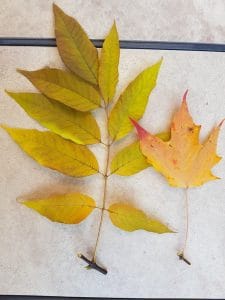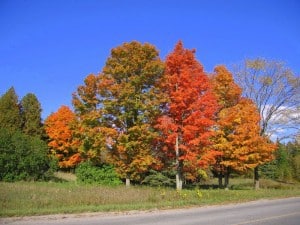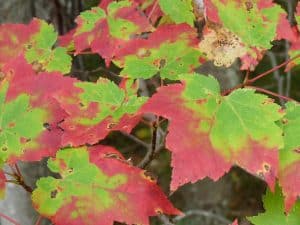In October, our attention is drawn to leaves like at no other time of year. They never cease to astound us with their blazing colours and wonderful, spicy smell as we rake them into piles. For the rest of the year, however, we mostly take leaves for granted. They just seem to “be there” doing nothing. But, like everything in nature, leaves are far more amazing than what initially meets the eye. Nothing about them is arbitrary or purposeless.
The characteristics of leaves only make sense when considered through the lens of evolution by natural selection – the process that favors the survival and reproduction of individuals that are best adapted to their environment. So, let’s consider leaves the way Charles Darwin would: By asking “why” questions. Let’s begin by exploring why trees have leaves in the first place. Simply put, leaves make food for the plant – be it a towering white pine or a lowly moss – so that it can grow. This happens through photosynthesis. “Photo” is the Greek word for “light,” and “synthesis” means “putting together.” That’s exactly what is happening. Leaves harness the energy of sunlight to make food in the form of sugars like glucose. Some of the glucose is immediately used for growth (e.g., the production of cellulose and lignin which makes up wood) while the rest is stored for later. Glucose is produced from two ingredients: carbon dioxide and water. Plants breathe in the carbon dioxide, an invisible gas, through tiny holes in the leaves. They use their roots to suck up water. Some of the water is released back into the atmosphere through the leaves by transpiration. At the same time as glucose is produced, oxygen is released as a waste product. Not only is photosynthesis responsible for the production and maintenance of most of the Earth’s oxygen, but it provides the organic compounds necessary for life on Earth. No small feat!
Photosynthesis is directly related to another why question: why are leaves green? Leaf cells house tiny structures called chloroplasts. Each chloroplast contains a green pigment (chemical) called chlorophyll, which absorbs the sun’s energy and carries out photosynthesis. As long as chlorophyll is present, the leaf remains green and oxygen and glucose are produced.
Colour change
This begs the question of why leaves change colour and why they are shed from the tree. Both of these phenomena are manifestations of the tree’s preparation for winter. It is a coordinated undertaking on the part of the entire organism. Since winter is a time of drought in which water is locked up in the form of ice, trees are less able to take up water through their roots – most of which are near the surface in soil that freezes. In addition, leaves are continually releasing water vapour through transpiration – think of the high humidity of a greenhouse. Trees must therefore get rid of their leaves in order to minimize water loss and death through desiccation. Also, the leaves of most trees are far too delicate to withstand the rigours of winter.
Before shedding their leaves, however, trees have evolved to salvage the scarce but valuable minerals or nutrients in the leaves. These were originally obtained from the soil through the roots. They include magnesium (an essential component of chlorophyll), calcium, phosphorus, potassium and nitrogen, which is part of all proteins. Given their relative scarcity, a tree can’t afford to lose most of these nutrients each fall when the leaves are shed. It wouldn’t be able to reabsorb them in time or in sufficient quantity to be available for the next generation of leaves. Therefore, as daylight begins decreasing in mid-July, trees start removing these nutrients from their leaves and storing them in the woody tissues until next spring. By sometime in September, the leaves can no longer manufacture chlorophyll and begin to lose their green coloration. At this point, other pigments like the yellows and orange carotenoids gradually become visible. These pigments were present in the leaves all along but were masked by the chlorophyll.
A group of red or purple pigments known as anthocyanins are also abundant in some leaves like those of white ash and both red and sugar maples. They are produced in late summer from excess sugars and are brightest in years with lots of sunny days and cool nights. Scientists are not yet certain about the role of anthocyanins but they may protect the leaves from ultraviolet light.
The actual shedding of the leaves is achieved by the formation of a cork-like “abscission” layer of cells at the base of each petiole (leaf stem). Eventually, the leaf’s connection with the twig is broken, and it falls off in the wind, rain or simply from the warming effect of the morning sun. You have probably noticed how squirrel nests, made up largely of leaf‑bearing twigs nipped off the tree during spring and summer, will hold their leaves for years at a time. This is because the cork layer never had the time to form so the leaves remain attached.
Other stories
Leaves have many other why questions to answer and stories to tell. To think like Darwin, let’s consider other challenges a leaf faces. These include being eaten, over-heating, drying out, being blown off the twig, receiving enough sunlight – to name a few.
You may, for example, wonder why so many different shapes and sizes have evolved. Scientists have discovered that toothed or lobed leaf margins (e.g., toothed in elms, lobed in oaks) are an adaptation that allow leaves to more quickly rid themselves of absorbed heat. If heat release is not a problem, as with plants like hostas that grow in shady habitats, the margins are “entire”, which means they are even and smooth all the way around. Almost all leaves, however, come to a sharp point – often at the tip – which is an adaptation to shedding water.
Darwin no doubt wondered why some leaves are “simple” like those of a maple or compound like those of a sumac or walnut. To tell if a leaf is compound, look at where the petiole (leaf stem) is attached to the twig (usually a different colour and woody). You should be able to see a bud. A simple leaf has a petiole and one blade. A compound leaf has an elongated petiole with three or more leaflets (blades) coming off it. Each leaflet looks like a separate leaf, but there is no bud at the base of the leaflet’s stem (petiolule) – only where the main petiole is attached to the twig.
Why would natural selection sometimes favour compound leaves? First, they provide lots of surface area for photosynthesis – sumacs can have 31 leaflets – but still allow wind and rain to largely pass through them. Imagine what would happen to a huge simple leaf in a storm! In addition, compound leaves don’t heat up so much because air circulates around the leaflets. These advantages may explain why compound leaves are so common in the tropics.

Compound leaf of ash (left) and simple leaf of sugar maple Note tiny bud where stem meets the twig – Photo by Drew Monkman
The overall size of leaves is not a matter of chance, either. Leaves tend to be largest on plants that grow in shaded areas – think of the size of Hosta leaves – and on the lower, more shaded branches of trees such as oaks. Leaves at the top of a tree tend to smaller. Larger leaves, of course, gather more light.
Leaf thickness, texture and hairiness are also interesting. Hairs and even spines on leaves have evolved to make them less appetizing to herbivores like caterpillars and deer. Hairs can also protect delicate growing parts from the cold. You often see them on early-spring species like hepatica and arugula. Thick and waxy leaves – think of conifer needles and the leaves of English holly – suffer less water loss, which means the tree doesn’t need to shed them in the winter. They are also common in hot, dry environments.
Take time to smell leaves and to ponder the question of why some leaves are so aromatic. Although certain leaves might smell good to us – wintergreen and bergamot, for example – it’s quite likely that the chemical compounds responsible for the smell are poisonous or taste bad to leaf-munching herbivores!
Leaf collection
Why not take some time this fall to really get to know the leaves of our common broad-leaved trees? One way is to make a collection, either by yourself or with your children, grandchildren or students. Place the leaves between sheets of newspaper with heavy books on top. Leave for a week or so. When the leaves have dried out, you may wish to place them between two sheets of clear, adhesive contact paper for greater protection. Using one or two sheets of Bristol board, group the leaves by colour, by genus (e.g., all the maples together) or by simple and compound. A basic collection for the Kawarthas would include simple leaves like sugar maple, red maple, silver maple, red oak, white birch, American elm, trembling aspen, American basswood, chokecherry and willow. As for compound leaves, try to find white or green ash, staghorn sumac, Manitoba maple, black walnut, Virginia creeper and black or honey locust.
Fall is a wonderful time to explore and celebrate nature, especially through the lens of why questions. Nothing in this Universe is more magical or awe-inspiring than reality!

